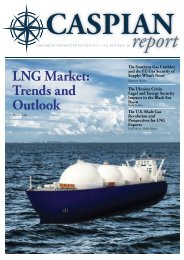Caspian Report - Issue: 07 - Spring 2014
You also want an ePaper? Increase the reach of your titles
YUMPU automatically turns print PDFs into web optimized ePapers that Google loves.
Aura Sabadus<br />
38<br />
other large rival that may enter the<br />
scene, is to offer flexibility and promote<br />
greater integration through appropriate<br />
infrastructure.<br />
It is expected that the price for <strong>Caspian</strong> gas paid<br />
by Turkish and European customers should be<br />
between 10 to 12% cheaper than that paid for<br />
Russian gas.<br />
Upholding the status quo by insisting<br />
on TPA exemption and failing to develop<br />
interconnectors with reverse<br />
flows connecting regional countries<br />
would not only fall short of Europe’s<br />
diversification goals, but also place<br />
the SGC at a severe disadvantage to<br />
South Stream.<br />
Furthermore, in their drive to secure<br />
further growth and lock in new<br />
markets, the Shah Deniz consortium<br />
should reconsider their ambitions to<br />
expand into Western Europe, which<br />
already benefits from multiple<br />
sources of supply and opt instead to<br />
compete directly with Russia in central<br />
and Eastern Europe, where there<br />
is a greater need for diversification.<br />
<strong>Caspian</strong> gas can beat off competition<br />
from South Stream, providing it is<br />
supported by flexible transport option<br />
and commercially viable terms.<br />
Commercially attractive<br />
A product is commercially viable if it<br />
brings financial benefits to both buyers<br />
and sellers.<br />
From a seller’s perspective it has<br />
been argued 12 that the choice of TAP<br />
was decidedly more attractive than<br />
its rival Nabucco West. TAP offered<br />
the Shah Deniz consortium a transit<br />
tariff of €3 ($4.11 at April <strong>2014</strong><br />
exchange rate) per 100 km of pipeline,<br />
fractionally cheaper than that<br />
advanced by Nabucco West over the<br />
same distance. TAP was also 459 km<br />
shorter than its competitor, making<br />
for even cheaper tariffs; the investment<br />
needed to build TAP was €4.4<br />
billion ($6 billion) compared to<br />
€6.6 billion ($9 billion) for Nabucco<br />
West. 13<br />
It is expected that the price for <strong>Caspian</strong><br />
gas paid by Turkish and European<br />
customers should be between<br />
10 to 12% cheaper than that paid<br />
for Russian gas. The exact values are<br />
not known, nor are the formulae by<br />
which they are determined. However,<br />
it may be assumed that they are<br />
largely linked to the price of oil and,<br />
from a buyer’s point of view, should<br />
be more competitive than those<br />
charged by Russia in the region.<br />
Nonetheless, the commercial viability<br />
of the Southern Gas Corridor<br />
should be seen not only against<br />
present conditions, but also in the<br />
long-term against the impact of two<br />
potential developments: competition<br />
from existing and emerging regional<br />
producers as well as US LNG<br />
and the future of oil indexation.<br />
This subchapter will discuss the viability<br />
of the SGC against these two<br />
developments and reflect on its potential<br />
to bring greater economic<br />
efficiency, its impact on the liber-<br />
12.<br />
Abbasov, S., Ibid.<br />
13.<br />
Ibid.










